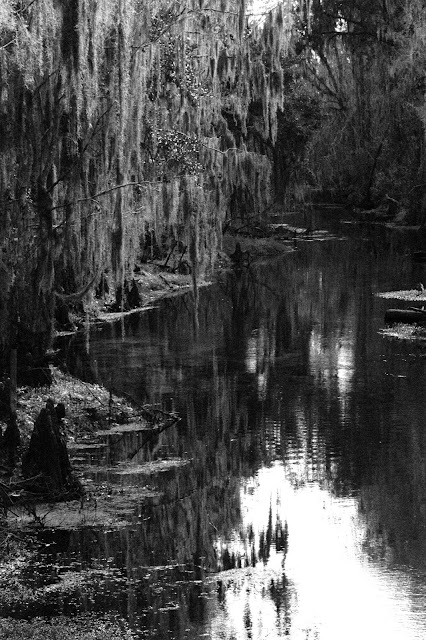GALLERY 10 TODAY
This page contains my top 10 post processed photos up to today. It is ongoing and will change everytime I do a photoshoot or work on a photo that merits being in the Gallery 10.
At the end of my course at Univ. of Alaska, AA590 Independent Study: Landscape Art in Florida, Dr. Herminia Din, Instructor of Record, this page will contain my 10 BEST photos and 1-2 paintings created at the Florida Highwaymen Workshop as required for this course.
Also included in this study is the photography of Clyde Butcher who resides in the Everglades National Park area. Clyde Butcher is well known for his Everglades photos and is recognized nationally and internationally as well. He is the "Ansel Adams" of our day in technical terms yet has developed his own style as well.
All photos on this website were taken by Dolores A. Russo and are legally copyrighted.
Any usage of any kind requires my written permission.
cDAR2013
 |
| Cypress trees - endangered species - on Shingle Creek, Headwaters of the Everglades Although symemtrical, the reflection makes this photo more interesting with a nice balance of lights and darks. |
 |
| Palmettos in the Woodlands A reflection of my graphic arts training! The darks and lights are reminiscent of Ansel Adams' Zone System. |
 |
| The layers of perspective achieved by dark to light makes this photo very effective. Notice the depth achieved in this photo. |
 |
| Palmettos and typical subtropical Underbrush Spiky linear leaves give this photo a "do not touch" feel |
Mangrove roots - where lots of little critters live, including baby alligators.
A good contrast of whites and blacks give this a graphic look as well.
Shingle Creek Park, Kissimmee, FL
One of my favorite photos -
This photo did not work well in black and white. It looks better in color
and looks like a painting.
It is on my list of "paintings to do when I am done with my course." But then again, I have a LIST of paintings I want to do after April 26th and would have never thought to do any of this if it weren't for the encouragement of my instructor, Dr. Din.
APRIL 15, 2013 REFLECTION: ART EDUCATION AP580, University of Alaska, AnchorageThis photo did not work well in black and white. It looks better in color
and looks like a painting.
It is on my list of "paintings to do when I am done with my course." But then again, I have a LIST of paintings I want to do after April 26th and would have never thought to do any of this if it weren't for the encouragement of my instructor, Dr. Din.
I am very pleased with the resulting photos selected for my Gallery 10 EXHIBIT.
I took over 700 photos to get 10 good ones here. My camera is a Nikon D70s with an assortment of lenses. Most of the photos were taken with my MACRO lens f/1.8. It was sharp and fast for the photos I needed. I did not use a tripod, although at times I wish I had done so. Most of the time I used AP setting: an aperture priority at F/8 to an F/11. At times I tried a smaller aperture, f/22 that yielded interesting results and better detail. But as we know...it is not the camera that takes the photo, it is the photographer.
I used Photoshop CS5 for refinement and black and white conversion. I tried different conversion techniques and like the LAB method best for control. Other Photoshop methods did not yield the sharp black and white I was aiming for. I referenced Ansel Adams' ZONE method frequently.
Many of my shots were influenced by the artwork of photographers and landscape painters as well. I visited many museums for this purpose to study work by American landscape artists such as Bierstadt, Cole, Moran and others. American photographers such as Adams, Weston, Muench and others were a great influence on my photography as well. They all provided the "teaching" I needed!
I used Clyde Butcher, Landscape and Everglades photographer as one reference, and Mr. James Gibson, one of the original Florida Highwaymen, as my painting reference specifically for Florida Landscape Photographer and Artist, respectively. I have met both artists.
My travels took me from one side of the state to the other, but due to an unforeseen illness in March, I was not able to make the trip south. I did go north however to Tallahassee, for photos and a workshop with Mr. Gibson. If you were to drive from north to south in Florida, it would take about 12 hrs. without stopping except for gas. It's a big state and I happen to live in the middle of it -Orlando!
In the vein of art education, I pursued this course as a possible introduction to the art of Florida for K-12 students. Although one might wonder how you could make a lesson plan for kindergarten out of this, you will be surprised at how interested little ones can be when it comes to looking at "pictures." You have to begin somewhere! I have done "landscapes" with kindergartners and with teachers as well.When I was training as a consultant for National Geographic my students, my peers, (classroom not art teachers from Connecticut} created collages of mountains after an introduction to American landscape paintings. (I won first place at the NG Summer Institute for this lesson plan!)
By taking this objective further, I can see lesson plans using these two artists, Butcher and Gibson, as the basis for a study in Florida art. There are many who do not believe that there is any art here in Florida. The impetus for this paper was based on that assumption. And guess what...there IS art here, it's good art and it has national recognition as well.
MORE PHOTOS...CLICK HERE http://floridalandscapeart.blogspot.com/p/more-photos.html








